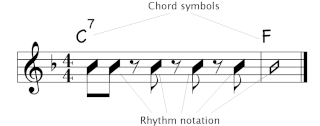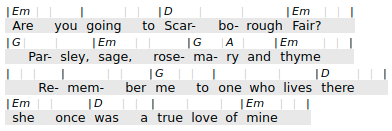Time in Music Notation
We explore various ways to represent music and how they show time (or do not), and we find an interesting opportunity.
Time in music
Each dictionary has a slightly different take on the word music. Wikipedia has a somewhat old-fashioned but nice definition:
Music is the art of arranging sounds in time to produce a composition through the elements of melody, harmony, rhythm, and timbre.
(emphasis mine)
Time is key. Many arts are static (writing, painting, sculpting, photography): both creation and fruition are free from time constraints. Other arts are dynamic (dance, theater, movies): they often have a music component and, like music, depend on movement, which creates time.
Music composition is actually free from time constraints since the invention of notation. Fruition, however, is not: at any given time, music is either playing or not playing.
Time and rhythm
The definition above mentions some of the main elements of music, and the same Wikipedia page describes them. The one directly concerned with time is rhythm, described as:
the arrangement of sounds and silences in time.
When music is playing, notes and pauses happen at definite moments, and those moments give music its rhythm. A sequence of the same notes and pauses, but with a different rhythm, is different music. Various music representations show different levels of detail for rhythm, or none at all.
Bars, beats and parts
Notes and pauses are placed in a grid of bars (a.k.a. measures), that help define the rhythm. Each bar is divided into beats, that are in turn divided into parts.
In most music, bars are divided into two, three of four beats, and each beat into two or three parts: combining beats and parts gives rise to meters. Two-part meters like 2/4, 3/4 and 4/4 are common in Western classical, pop and rock; three-part meters like 6/8, 9/8 and 12/8 are common in folk, blues and jazz.
Sheet music
Modern music notation, also known as sheet music:
uses musical symbols to indicate the pitches, rhythms, or chords of a song or instrumental musical piece.
Sheet music represents rhythm by placing each note or pause inside bars at precise points, also showing how long each one lasts. In the case of a song, sheet music also shows the song lyrics, with each syllable written under its note, to indicate the moment it should be sung.
Here is a staff from a traditional English ballad, Scarborough Fair, in the Simon & Garfunkel version:

Tablatures
Somewhat parallel to this exploration is the world of guitar tablatures, where the staves are replaced by physical indications of which strings to play on which guitar frets. They may or may not present any rhythmic information, chords or lyrics.
Alternate notations
Sheet music is quite comprehensive but also rather difficult to read and write. Several alternate notations evolved by simplifying or omitting certain music elements. This allows more freedom in improvising accompaniment and even melodies; it also needs fewer pages, helping musicians with a repertoire of hundreds of pieces.
The first casualty is the exact detail of notes played, replaced by chord symbols: instead of precisely specifying which notes should be played, the notation only prescribes a subset of them (harmony), leaving the musician partially free to pick which notes to play.
Lead sheets
Lead sheets still use staves, where only the melody is notated. Chord symbols above the staves indicate the harmony, and lyrics (if any) are shown below the staves.
Here is a staff from the above ballad (traditional version):

Rhythmic and slash notation
Next step, we omit the melody. We have to know it by heart, or maybe we do not need it at all, someone else is going to play or sing it.
Rhythmic notation still has staves, but they are only used to show the rhythm of the chords.

Slash notation is similar, but the rhythm of the chords is not shown in detail: the staff only shows bars and beats.

The staves are not really needed at this point: this can be shown in a more compact way without them.
Jazz chords
Jazz accompaniment is usually concerned with rhythm and chords. In this format we keep bars and chord symbols, and lose the lyrics. Here is an example:

The placement of the chords in each bar shows when they should be played: the beats are not explicitly indicated though.
CRD song sheets and ChordPro
These two formats are instead concerned with chords and lyrics, and omit any explicit rhythm information: the timing of the chord changes is synchronized with the lyrics.
CRD song sheets keep the chord symbols on top of the lyrics but lose the bars: to know when to play each chord, the musician has to rely on the lyrics as the only remaining rhythmic information.
Many songs in this format may be found on websites like Ultimate Guitar and Chordie. Here are two lines of Scarborough Fair:
Em D Em G Em G A Em
Are you going to Scarborough Fair? Parsley, sage, rosemary and thyme
G D Em D Em
Remember me to one who lives there, she once was a true love of mine
The ChordPro format source text moves the chords next to their words in square brackets:
[Em]Are you going to [D]Scarborough [Em]Fair?
[G]Parsley, [Em]sage, rose- [G]ma- [A]ry and [Em]thyme
Remember [G]me to one who lives [D]there,
[Em]she once [D]was a true love of [Em]mine
The output is similar to the CRD text, but is more beautiful and flexible.
Feature summary
This table summarizes the various formats' features:
| Name | All notes | Melody | Staves | Lyrics | Chords | Rhythm |
|---|---|---|---|---|---|---|
| Sheet music | ✔ | ✔ | ✔ | ✔ | ✔ | All |
| Lead sheet | - | ✔ | ✔ | ✔ | ✔ | All |
| Rhytmic notation | - | - | ✔ | ✔ | ✔ | All |
| Slash notation | - | - | ✔ | ✔ | ✔ | Beats |
| Jazz chords | - | - | - | - | ✔ | Beats |
| CRD / ChordPro | - | - | - | ✔ | ✔ | - |
| LCR | - | - | - | ✔ | ✔ | Parts |
-
LCR
By removing the staves, jazz chords, CRD and ChordPro achieve remarkable
compactness; however, each of them loses something important. A format is
needed that keeps all three of lyrics, chords and rhythm, while managing to
stay almost as simple and compact as both jazz chords and ChordPro. Its name
is the acronym LCR.
Here is how the two lines above appear in this format:

The beats boundaries are shown by the light grey bars. Not only the chords, but also each syllable can be precisely placed: notice how the bo- in Scarborough falls on the second part of the beat. The width of the beats adapts to the length of syllables and chords so that no space is wasted, but the rhythm is still clearly indicated.
This format was discussed on the ChordPro forum in March 2021.